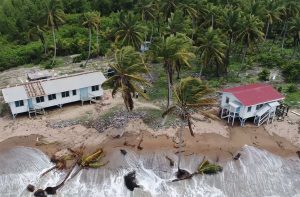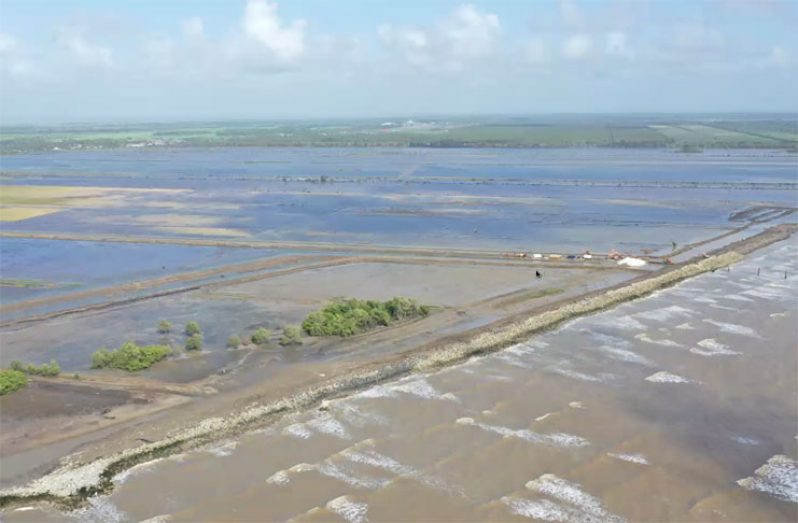— experts urge that ‘we must act now’
By Lisa Hamilton
GUYANA’s coastland is below sea level which continues to rise, year after year, as the grim effects of climate change take place. However, if Guyana does not act fast and efficiently, it stands the chance of putting not only its coastland but the lives and livelihoods of thousands at risk.
These were the pressing concerns examined by environmental experts, on Thursday evening, during a webinar hosted by the Georgetown Chamber of Commerce and Industry’s (GCCIs) Green Economy Committee on the climate change impact to Guyana’s coastline.
To present a clear image of this impact was Environmental Filmmaker, Alex Arjoon, who presented some of the footage he has recorded over the years which has since been put into a documentary.
A GRIM REALITY
His work showed waves, over 6 feet high, crashing over the seawalls in places such as Mahaica, Den Amstel, West Coast Demerara, and Kitty, just outside the Russian Embassy. On one occasion, he and his team were too close to seawalls and the force of the waves was strong enough to put a dent in their jeep.

In other videos, he showed parts of Shell Beach where an entire community was almost washed away due to high rising sea levels and abandoned kokers and sluices that were now surrounded by the sea due to a sinking coastline.
“Overtopping isn’t a joke. I think a lot of people don’t understand how badly it affects communities. When that water floods the area, not only is it damaging property and just a general threat, but it’s also a sanitation issue. There are a lot of outhouses and sceptic tanks and all that stuff in the properties right there and all those things get flooded and the water mixes and then floods the area and leave ourselves open to the hazards of whatever germs are being carried,” Arjoon explained.
He also pointed to the Dantzig/Mahaicony area on the East Coast of Demerara (ECD) which has been plagued with overtopping and flooding for some time due to its deteriorating sea defence. Salt water, making its way on to rice fields and contaminating the drinking water for livestock, continues to cost farmers millions.
Though the government has launched relief efforts and continue to reinforce the sea defences through riprap and mud dams, these have to be constantly reinforced against time and the worsening climate change.
Arjoon said: “Even when fixing this, you only have a limited amount of time before the tide comes in and when it’s high tide you essentially cannot do anything and it can undo a lot of the work that’s been done.”
MORE THAN MANGROVES
If Guyana’s existing sea defences are left as they are, communities will continue to experience more over-topping and flooding due to global warming.
This is according to Lecturer at the Department of Biology at the University of Guyana (UG), Mark Ram, who also made a presentation on whether mangroves alone were sufficient for coastal protection in Guyana.
Ram said that, in reality, Guyana has its unique vulnerabilities such as its geographic location whereby its coast is located below sea level; its high coastal population density, whereby the majority of the population resides on the coastland; and, its centralized economic activities, whereby it has not had the past means to invest in the necessary defence structures.
Guyana’s coastal defence structures are primarily concrete seawalls, rock rip-rap, mangroves and earthen embankments. The legislative capacities in place to address environmental challenges include the Sea Defense Act Chapter 64:02; the Drainage and Irrigation Act (Act 10 of 2004) and the Environmental Protection Act Chapter 20:05.
Meanwhile, institutional capacity includes the Sea Defence Board, the Sea and River Defence Division and the Regional and Neighbourhood Democratic Councils.
However, even with these capacities in place, Ram said that Guyana’s coastland remains at risk due to a number of factors.
As it relates to mangroves, which serve as a natural form of coastal protection, Ram noted that Guyana has lost over 80 per cent of its mangroves since 1983 when it possessed approximately 150,000 hectares but now, as of 2018, possess only 33,361 hectares.

“We have lost not only the mangroves that naturally existed but we’ve also lost some of the mangroves that we have replanted as part of the restoration project,” he said.
The Biology Lecturer said that while persons have become more aware of the importance of mangrove and wish to assist with replanting, such efforts require financing and specific requirements for successful mangrove growth such as the elevation of mud, tidal hydrology and conditions favourable for replanting.
“It’s not that we don’t want to replant the mangroves or we can’t advance mangrove restoration projects, either from a community basis, a voluntary perspective or even a national endeavour, but it’s just that some of the requirements are just not here for us to replant mangroves,” he explained.
Ram concluded that mangroves alone are not sufficient for the protection of Guyana’s coastlands and citizens should begin thinking about moving to inland, to higher ground and about taking different, more modern steps to mitigate the effects of climate change.
In another presentation, Eco-Green Proprietor, Mario Armes, said that it has been averaged that it would take around US $1 billion to conduct a serious re-building of Guyana’s seawall. However, he believes that if reconstruction is being done, this must utilize modern best-practices and technologies.
He gave examples of companies around the world that specialise in these technologies and in areas relating to soil engineer, synthetic tube manufacturing, breakwater systems and more.
Armes also recommended that Guyana develops a programme to reclaim its foreshore which could be affordably done utilising Geotubes. “We need to think globally and act locally and protect our coastland,” he said. Following the presentations, members of the public who attended were allow to ask their pressing questions and have them answered.




.png)









